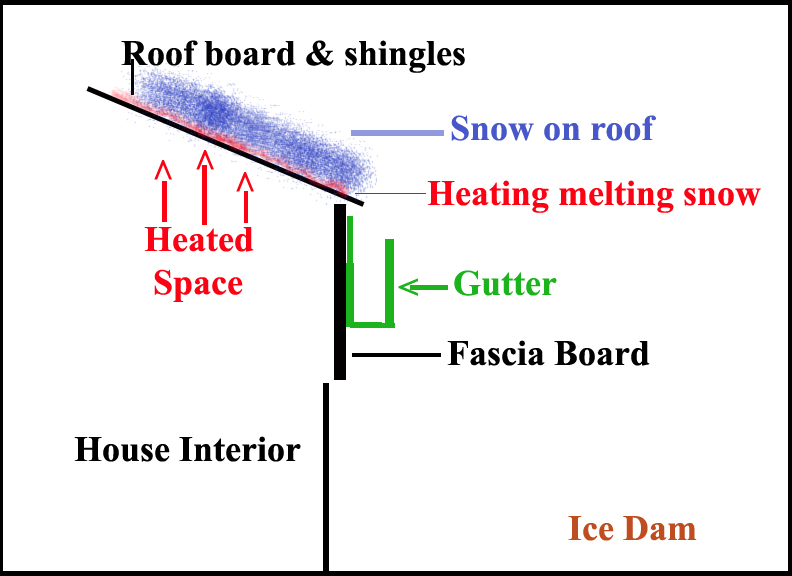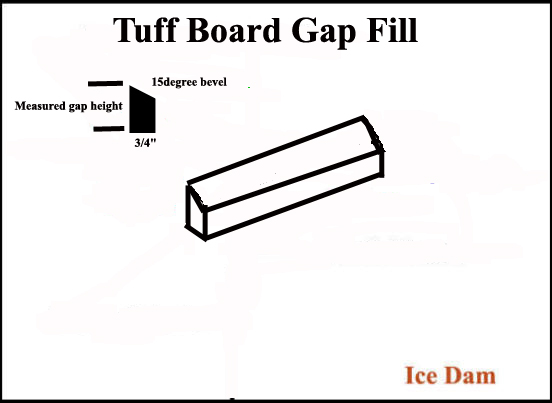Ron Stultz
"How to: Solve an Ice Dam Problem"
Summary: Short term: locate where water getting into house, remove all ice from gutter in area of leak and keep it out and reduce interior heat. Long term: going to have to fix junction of roof board and fascia board.
Background:
Winter of 2010 worse on record in Northern Virginia. Received 20+ inches of snow at one time and then the temperature stayed below freezing for days and days. Then one night, noticed large water blister in drywall ceiling of one room. When blister punctured, large amount of water! What? First time I learned the hard way about "ICE DAM."
Ice dam.
Recipe for an ice dam and associated leak into house: heavy snow on roof; poorly insulated attic; prolonged below freezing temperatures; gutters full of ice; gap between gutter fascia board and roof board.

Normally, water runs down shingles of roof and into gutter attached to fascia board.

Unlike rain that runs off the roof into the gutter right away, snow can accumulate on the roof, sometimes feet deep.

Above any area that is heated, no matter how well insulated the space between living space and roof board is, the roof board will always be warmer than outside and so snow begins to melt right at the shingles. Additionally, if there is a gap between the roof board and fascia board, heat will find this gap and warm right at the roof shingle edge, accelerating snow melt at the edge of the shingles

If the outside temperature is warm enough, the water that drips from melting snow is carried way by the gutter as it is designed to do but if the outside temperature stays below freezing for a prolonged period of time, ice begins to form in the gutter and eventually the downspouts clog with ice.



When the gutter is full of ice, new snow melt continues to drip until the gutter begins to round at the top. Once rounded, new water tries to run back up under the shingles towards the interior of the house.

If there is the smallest gap between the roof board and the fascia board, melted water that cannot go into the gutter because it is full of ice will stream down into the interior of the house.....ice dam.
Short term solution:
If your gutters are full of ice, any new snow melt is going to have no place to go but potentially into the interior of your house, so if possible, get gutters clear of ice. Yes, this can be dangerous as most gutters are high up. Your downspouts are most likely going to be frozen solid with ice and I have no real solution to unclogging them but with gutters along the roof edge, a rubber hammer and chisel will work to break ice into chunks that can be removed.
In my case, the ice dam formed at the junction of 2 roofs and if your interior leak is anywhere close to roof junctions, I would start there.
Besides removing ice in the gutters, reducing interior heat will help lower roof board temperature and thus slow snow pack melting.
And, dangerous, but roof snow removal.

Long term solution:
I am 65 years old and never experienced an ice damn until last winter and perhaps I never will again. As defined above, several things must happen for an ice dam to create a problem with the most significant, being lots of snow on the roof and prolonged below freezing temperatures. So, like people that live along a river, that only expect to be flooded every 10 years or so and just live with that fact, in the case of an ice dam, I suspect if I had done nothing at all in terms of a long term solution, would be ok.
But in my case, there was also a structural problem that contributed to the ice dam ceiling damage and I felt compelled to try to fix it.

Long term:
1.Insulate attic to reduce heat warming roof board and thus snow. Yes, the sun is going to melt some snow no matter what but insulation can only save you money in the long term on heating bills.
2. Look for gaps between the roof board and fascia board. In my case, right at the junction of 2 roofs, I found that the roof board did not come all the way down and over top the fascia board but that did not stop the roofer from applying shingles that hung over the gutter. Again, 99% of the time, this arrangement works just fine, but when the gutter is full of ice, snow melt has to go somewhere and this gap between the roof board and fascia board is an easy route.

My long term:
1. Bought 3\4 inch thick, 5 1/2inch wide, 8 feet long piece of Tuff Board. This composite board is rot proof.
2. Bought several tubes of Henry roof caulk\cement.
3. Bought a roll of rubber membrane roofing. This is used in place of normal tar paper and all roofing nail holes seal themselves.
4. Bought a tube of silicon caulk. 50 year guarantee stuff.
5. Took a pry bar used to remove roofing and gently separated the shingles overhanging the gutter from the those nailed above it.
6. Using the pry bar, removed the roofing nails holding the shingle nailed to the roof board.
7 If shingle overhanging gutter came loose, removed it, otherwise, removed roofing nails through shingle on top and separated it from shingle further up roof.
8. When I had shingles removed that once overhung gutter, measured gap between roof board and fascia board and using Tuff Board, cut a strip 3\4 inch wide, by height of measured gap. Once cut, beveled one edge for a 15 degree slope. Roof slope certainly varies but 15 degrees is commonly used in building as a minimum water run-off.

9. Fitted Tuff Board into gap between roof board and fascia board and attached to butt end of exposed roof truss using stainless steel screws.
10. Took silicon caulk and caulked edge of Tuff Board along roof board and along fascia board.
11. Cut a piece of rubber roof membrane and fitted it up on roof, such that it fit right on top of newly installed Tuff Board and extended up onto roof board good 12-14 inches..
12. Using Henry roof cement\caulk, put bead of caulk on Tuff Board edge and where rubber membrane to sit on roof board.
13. Placed rubber membrane on roof board and with front edge sitting on Tuff Board, nailed rubber membrane to Tuff Board.
14. Nailed rubber membrane to roof board.
15 Used Henry caulk to caulk edge where rubber roof membrane started on roof board.
16. Taking removed shingles, placed back on roof board and using Henry caulk and roofing nails reattached all shingles.
17. Where pry bar used to separate shingles from each other, new bead of Henry roof caulk\cement.
18. If shingle had a tear or a roof nail hole, used Henry caulk to repair.
In summary then, I attempted to close the gap between the installed roof board and the fascia board such that there was no gap for either warm attic air to escape and also to close off a water entrance route.